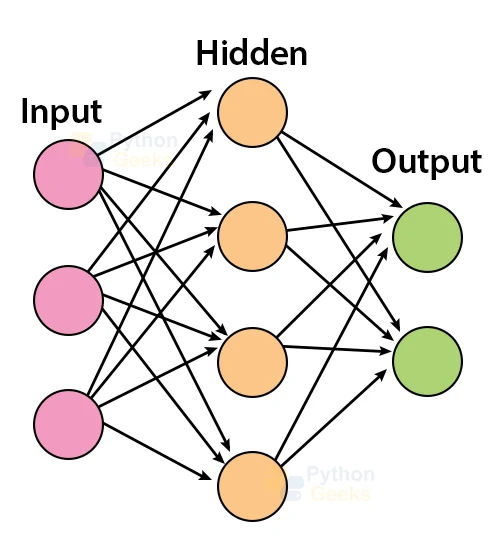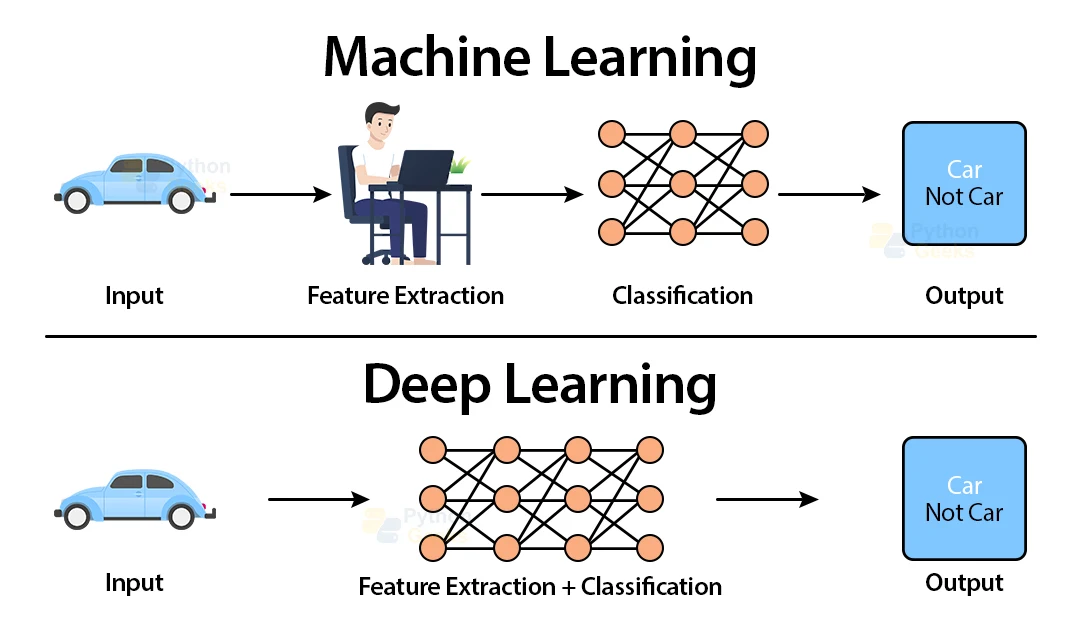Deep Learning vs Machine Learning
FREE Online Courses: Click, Learn, Succeed, Start Now!
Are you often confused between the terms Deep Learning and Machine Learning and are unable to distinguish technology from the other? Are you amongst those who think that Deep Learning and Machine Learning, both mean the same and perform the same tasks? Well, to burst your bubble, these two terms aren’t the same. Though both of them are a subset of the Artificial Intelligence domain, both of these technologies are different from each other.
PythonGeeks brings to you, an article that talks about the major difference between these two technologies. Though these technologies seem to have the same purpose and implementation, this article will articulate the difference in a rather comprehensive and easy-to-understand way. So, without further ado, let’s dive straight into the article and look at the introduction of both the technologies followed by their differences.
What is Machine Learning?
In general terms, Machine Learning is a subset of artificial intelligence that mainly focuses on a specific goal: setting computers up so that they would be able to perform tasks without the need for explicit programming.
Here we feed the computers with structured data (in most cases) and with which the computers tend to ‘learn’ to become better at evaluating and acting on that data over time.
We can think of ‘structured data’ as data inputs that we can arrange in columns and rows format. We might fabricate a category column in Excel by the name ‘food’, and have row entries such as ‘fruit’ or ‘meat’. Computers can easily interpret and analyze this form of ‘structured’ data, and the benefits are quite obvious.
Once we program these instructions, a computer can take in new data indefinitely, sorting and acting on it without the need for further human intervention.
With increasing time span, the computer may be able to recognize that ‘fruit’ comes under the category of food even if we stop labeling the data. This ‘self-reliance’ is so fundamental and preliminary to machine learning that the field breaks down into subsets on the basis of how many ongoing humans the computers require.
Some of the useful and widely used Machine Learning algorithms are:
- Decision Tree algorithm
- Naïve Bayes
- Random Forest
- K-means clustering
- KNN algorithm
Types of Machine Learning
1. Supervised Learning
As you would have guessed from the name, Supervised Learning has the presence of a supervisor or an instructor. Algorithms classified under this type of learning deal with “labeled data” or “trained data”. By labeled data, we mean the data that has already been tagged to the corresponding correct answer. Now, you can use this trained dataset as an instructor to predict the accurate output for the new set of input data. In simple words, this type of learning basically maps the variable input with the correct output on the basis of the trained data.
2. Unsupervised Learning
In Supervised Learning, we understood that you can train models using labeled data to predict the output. However, the problem with that approach is that every dataset doesn’t have labeled sets and, in such cases, we have to look for hidden patterns in the datasets.
As the name suggests unsupervised learning, unlike Supervised Learning, algorithms do not require any instructor to guide the output. As opposed to supervised learning, these algorithms tend to train the models in such a way that the models themselves find the patterns and insights hidden in the input dataset.
3. Reinforcement Learning
We make use of these algorithms to choose an action that the agent has to undergo. Apart from this, we can see that it is based on each data point present in the dataset. Furthermore, after a period of time, the algorithm changes its strategy to learn better and aims to achieve the best reward.
How does Machine Learning Work?
As we have seen in many articles, Machine Learning models work efficiently with the help of their training algorithms. We can understand the working of machine learning models by the example of identifying the image of a cat or dog. To identify this, we feed in the Machine Learning model with the images of both cat and dog as input. The Machine Learning model then extracts the different features of images such as shape, height, nose, eyes, and so on. The model then applies the classification algorithm, in order to predict the output.
Where do we use Machine Learning Today?
It might surprise us to know that we interact with machine learning tools on an everyday basis. Google uses the Machine Learning models to filter spam, malware, and attempted phishing emails out of our inbox. Our bank and credit cards make use of it to generate warnings about suspicious transactions and illegitimate actions with your accounts.
When we instruct personal assistants like Siri and Alexa, machine learning drives the voice and speech recognition platforms at work. Furthermore, when our doctor recommends us to a specialist, machine learning may be helping them scan X-rays and blood test results for the diagnosis of anomalies like cancer.
As the range of applications of Machine Learning continues to grow, people are turning to machine learning to take care of their increasingly complex and vast types of data. As a result, there is a strong demand for computers that are able to handle unstructured data, like images or video. This demand gives way to the entry of Deep Learning.
What is Deep Learning?
Machine learning deals with computers that are able to perform tasks without being explicitly programmed. However, these computers being machines at the root level, still think and act like machines. Their abilities to perform certain complex tasks like gathering data from unstructured inputs like an image or a video still lag far short of what we as humans are capable of processing.
With the help of Deep learning models, we can introduce an extremely sophisticated approach to machine learning. Because of this, we are set to tackle these challenges since these models are specifically modeled after the human brain. We have built complex, multi-layered, and proficient “deep neural networks” so that we can allow data to pass between nodes (neurons) in a highly connected way. As a result of this, the output of these models is a non-linear transformation of the data that is increasingly abstract and modular.
Deep Learning works technically in the same fashion as machine learning does, however, with different capabilities and approaches. It is highly inspired by the functionality of the biological processing units, which are called neurons, and this paves the way to the concept of artificial neural networks. Other common reference terms for this technology include a deep neural network or deep neural learning.
In deep learning, models make use of different layers of their complex structure to learn and discover insights from the data.
Some of the most popular deep learning models are:
- Convolutional Neural Network
- Recurrent Neural Network
- Autoencoders
- Classic Neural Networks
How does Deep Learning Work?
In an attempt to understand its works, we can consider the same example of identifying cat vs. dog. We feed in the deep learning model with the images as the input and further feed them directly to the algorithms without the assistance of any manual feature extraction step. The images traverse to the different layers of the artificial neural network structure and predict the final output, which is highly precise and reliable based on the number of layers of the structure.
Difference Between the Technologies
Now that we know the basics of both technologies, let us quickly look at the major differentiating points between the two technologies. In order to understand them better, we will go through the differences in a tabular format.
Apart from these differences, we can also observe the following differentiating points of the technologies:
| S.No. | Machine Learning | Deep Learning |
| 1 | Machine Learning is a superset of Deep Learning | Deep Learning is a subset of Machine Learning |
| 2 | The data represented in Machine Learning is quite different as compared to Deep Learning as it uses structured data | The data representation is used in Deep Learning is quite different as it uses neural networks(ANN). |
| 3 | Machine Learning is an evolution of AI | Deep Learning is an evolution to Machine Learning. Basically, it is how deep is machine learning. |
| 4 | Machine learning consists of thousands of data points. | Big Data: Millions of data points. |
| 5 | Outputs: Numerical Value, like classification of score | Anything from numerical values to free-form elements, such as free text and sound. |
| 6 | Uses various types of automated algorithms that turn to model functions and predict future action from data. | Uses neural network that passes data through processing layers to interpret data features and relations. |
| 7 | Algorithms are detected by data analysts to examine specific variables in data sets. | Algorithms are largely self-depicted on data analysis once they’re put into production. |
| 8 | Machine Learning is highly used to stay in the competition and learn new things. | Deep Learning solves complex machine learning issues. |
What to Prefer Over Machine Learning and Deep Learning?
Though considering the differences between both these technologies is not enough, we need to have an insight into the choice of technology that we need to implement depending on our problems. Though choosing between the two technologies can be quite troublesome, we can follow a simple rule to choose them.
When you have high-end resources like high computing power GPUs and high data storing memory devices, then you should definitely choose Deep Learning over Machine Learning for accuracy and dependency. However, if you lack any of these, then you should go with the conventional low computing-powered Machine Learning models.
Applications of Deep Learning and Machine Learning
1. Machine Learning technologies are extensively used for medical imaging. As an example, consider the application of finding tumors and other malignant in the human body.
2. In the domain of Marketing, we make use of Machine Learning-based time-series forecasting are for predicting sales.
3. Deep Learning plays a pivotal role in the development of industrial robotics. In the industry of self-driving, we make use of machine learning algorithms for navigating the vehicle to its destination.
4. Industries use Natural Language Processing, or NLP, to analyze customer reviews and gain insights into their sentiments.
Future of Deep Learning and Machine Learning
With advancing technologies and increasing data complexities, Machine and Deep learning will affect our lives for generations to come. Virtually every industry will be transformed by their capabilities to provide efficient and reliable training models. Dangerous jobs that cause threats to human resources like space travel or work in harsh environments might be entirely replaced with machine involvement with bots and other learning models.
At the same time, there are high possibilities that people will turn to artificial intelligence to deliver rich new entertainment experiences that seem like scenes from science fiction.
Conclusion
Thus, we have reached the end of this article from PythonGeeks. We saw the difference between two emerging technologies of today’s world- Deep Learning vs Machine Learning. We came to know about the fundamentals of these technologies and their working descriptions. Towards the end, we saw the differentiating factors between these technologies and also learned about the future scope of these technologies. Hope that this article was able to deliver a useful insight to clear your understanding of these technologies.

